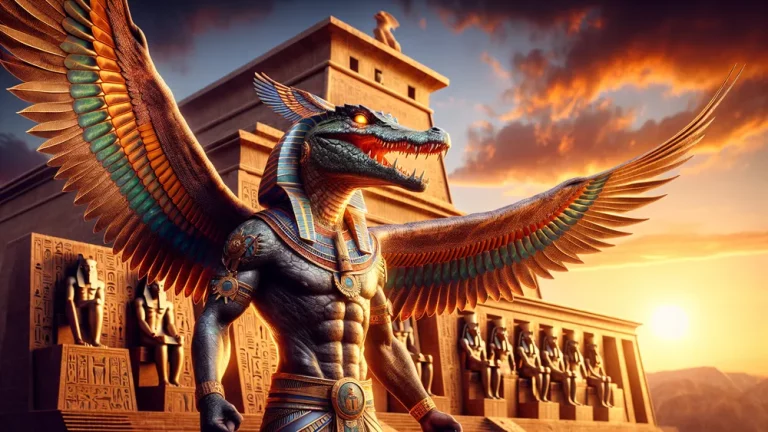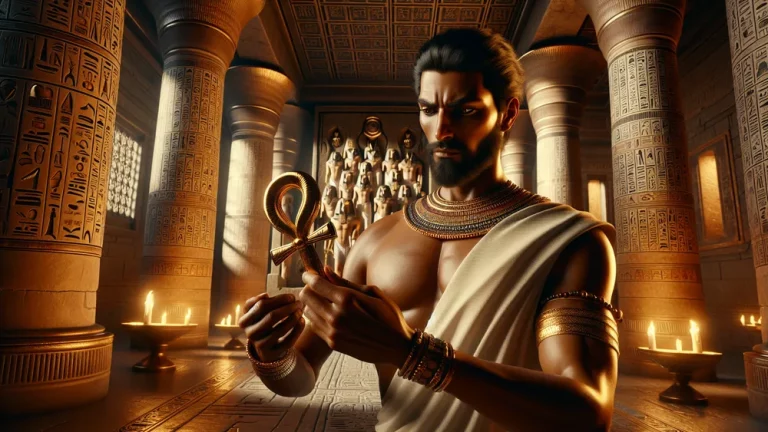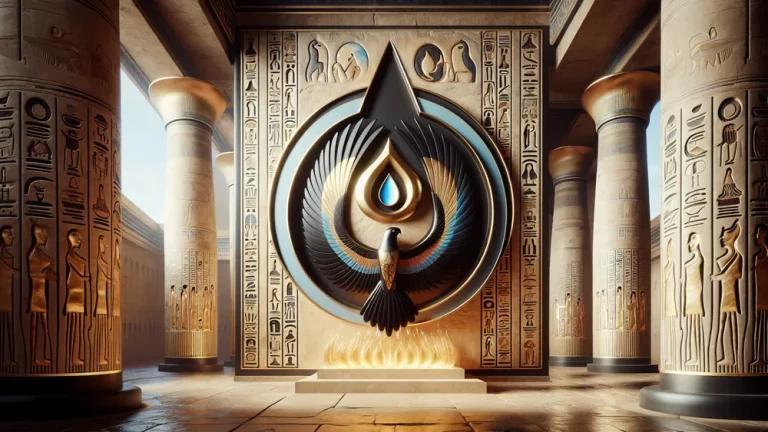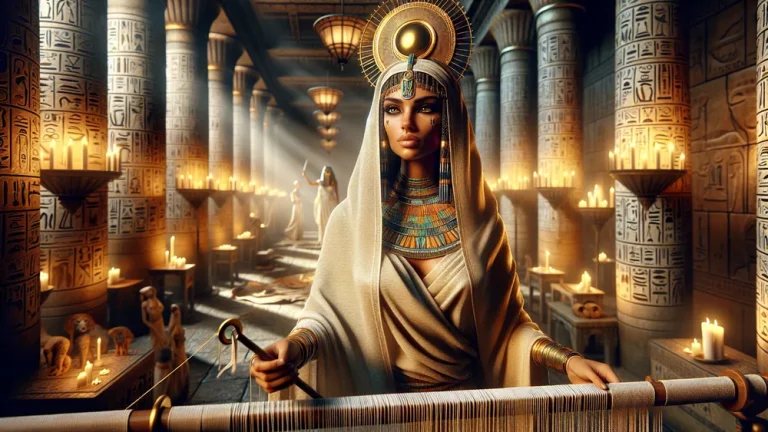Peneus: The Thessalian River God In Greek Mythology
In the wide collection of Greek myths, Peneus is an interesting figure who connects gods with nature. He was the god of the river Peneus in Thessaly, and his role is a combination of two things – just like many other gods in the ancient stories.
Key Points:
- Peneus is a river god from Thessaly in Greek mythology, representing the Peneus River and connected to fresh water and landscapes.
- He is the son of Oceanus and Tethys, making him one of 3,000 river gods, along with siblings like Achelous and Scamander.
- Peneus’ most well-known myth includes his daughter Daphne, whom he turned into a laurel tree to protect her from Apollo.
- The Peneus River shaped the Vale of Tempe, a famous spot in Greek culture, blending natural beauty with spiritual meaning.
- His son Hypseus was a Thessalian king who fought in myths like the battle between the Lapiths and Centaurs.
- Greek art often pictured Peneus with a beard and water-related symbols, tying him to rivers and their life-giving role.
- River gods like Peneus symbolized not just water but also protection, boundaries, and the strong link between nature and the divine.
He was a single god respected by the Greeks, one of the Potamói gods, who were thought to control water like rivers. But at the same time, he is also the real, physical river that goes through Thessaly’s green lands.
The importance of this connection, the one where something is both a god and also something that exists around you, was something the Greeks believed in a lot. They thought the sun was both a big glowing thing in the sky and also Helios moving it around. So, the Peneus River was not just water.
It was much more – a god, a place people depended on, and a thing that marked areas. There are many reasons why Peneus mattered in Greek mythology. He took part in several big stories. One of these is about Daphne, his daughter, who changed into a laurel tree when she wanted to avoid Apollo chasing her. These types of stories helped the Greeks understand the events they saw in nature and in their lives.
Rivers and land were built into their religion and stories in ways that gave everything meaning. Peneus also had a role as a protector of his river, which means he stood for water as a thing that gives life and can even change things.
Because of all this, Peneus was not just a god people respected but also showed how closely nature and gods were linked – a key idea in Greek thoughts about the world.
Peneus: Overview and Key Facts
| Category | Information |
|---|---|
| Name and Origin | Peneus (Πηνειός in Greek) is named after the Peneus River in Thessaly, Greece. |
| Type of God | River deity (Potamós), linked with the earliest gods of fresh water from Greek mythology. |
| Parentage | His father and mother were Oceanus and Tethys, the Titans representing Earth’s waters. |
| Siblings | One among 3,000 river gods and nymphs. Important siblings include Achelous and Scamander. |
| Domain | The Peneus River, a key part of Thessaly’s geography and identity. |
| Children | Daphne, connected to her story of transformation, and Hypseus, a Lapith king. |
| Role in Stories | Helped connect gods and mortals by assisting his children or reshaping the central lands of Thessaly. |
| What He Symbolized | Water as life-giving, its ability to change things, and ideas like protection and divisions. |
| Artwork and Images | Often shown as a bearded man with water jugs or as part of nature in peaceful settings. |
| Cultural Importance | Seen as both a part of geography and a god, bridging nature with Greek religious ideas. |
Who is Peneus?
If you want to really understand Peneus’ importance in Greek mythology, you need to learn about where he came from, who his family was, and the major roles he had. He was known both as a river god and as a father to people who appeared in big myths. And so, we should go into more of those details.
Where Peneus Comes From and Who His Family Is
In Greek mythology, Peneus is part of the group of gods called the Potamói, who were connected to rivers and their importance. He was one of the many children of Oceanus and Tethys, two Titans tied to water. Oceanus was thought of as a massive, untamed ocean wrapping around the world, while Tethys stood for fresh water and its ability to support life.
Together, they became parents to a huge number of children – about 3,000 river gods and 3,000 Oceanids (water nymphs). These children reflected both their parents’ traits. Like the others, Peneus blended his parents’ power over water with a more specific identity: he was not just a river god but also the Peneus River in Thessaly.
Other siblings of Peneus include Achelous, who was linked to a major river in western Greece, and Scamander, the river god known for his role during the Trojan War. Another sibling, Styx, held a place as the river of the Underworld, being tied to oaths and promises.
This group of water deities formed a key part of Greek myths by connecting natural elements, like rivers, to divine influence through stories. Peneus and the other river gods were greatly respected by the ancient Greeks because of how much rivers mattered. These waterways were not just places but provided food, helped with travel, and allowed farming to succeed.
The Greeks often thought of rivers as gods who gave protection and controlled the land. The Potamói were usually pictured as beings with human traits, like bearded men, often shown resting near water or holding large vases from which water poured.
Rivers like the Peneus River were also important for marking land and setting boundaries, so the god naturally became connected to ideas of protection and community. By tying each river to a god, like Peneus in Thessaly, the Greeks made their spiritual beliefs rooted in the real places they lived.
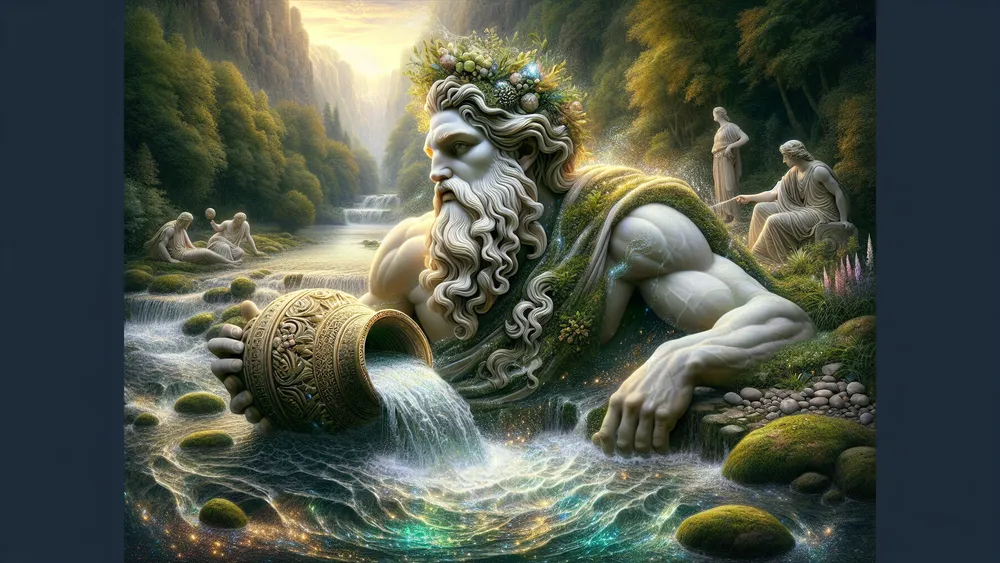
This way of understanding rivers and gods helped create a view where nature and divinity worked together, making the land seem both practical and sacred.
Peneus, a river god in Greek mythology, represented the Peneus River in Thessaly and highlighted how the Greeks connected rivers to gods to blend nature, practicality, and divine meaning.
How Peneus Connects with His Kids
The story of Daphne, Peneus’ most famous child, helps explain his role as a father. In Ovid’s Metamorphoses, Daphne is described as a nymph who was very beautiful and caught the attention of Apollo, the god. After being struck by one of Eros‘ arrows, Apollo became completely fascinated by her and could not stop chasing her.
But Daphne wanted to stay free and avoided every suitor who came her way. Because Apollo kept pursuing her, she went to her father, Peneus, and pleaded for his help. Peneus, seeing how desperate she was, transformed Daphne into a laurel tree to protect her. She could no longer take her human form, but she was now safe forever.
Apollo, although very upset, declared the laurel an essential symbol for him and used it to represent things like victory and art. This myth is an example of how Peneus actively protected his child while also connecting the natural world to gods through events like this. Another connection Peneus had with his children was with Hypseus, his mortal son.
Hypseus was a ruler of the Lapiths, a famous group from Thessaly. He is mostly remembered for his role as king during the well-known fight between the Lapiths and the centaurs, which happened at a wedding feast. As the son of a river god, Hypseus was not only connected to divine ancestry but also had the burden and responsibility of leading his people.

His part in mythology helps explain how Peneus’ importance wasn’t just tied to divine myths but also to human leaders and their histories. This interconnection between gods, mortals, and their shared influence was a common theme in Greek mythology.
- Notable Connections Between Peneus and His Children:
- Daphne: Her father turned her into a laurel tree so she could escape Apollo. Later, the laurel became Apollo’s symbol for success and victory.
- Hypseus: A Thessalian king who led the Lapiths and was known for his part in the fight against the centaurs, showing Peneus’ legacy among mortals.
Peneus as a River and a God
Peneus has an unusual role in Greek mythology because he is both a river god (Potamós) and the Peneus River itself, located in Thessaly. As a god, Peneus was recognized for his ability to support life and for helping change and shape the land. Water from Peneus was believed to help people survive, divide land, and grow food.
The actual river was real and flowed through the Vale of Tempe, an important and beautiful area with agricultural and tectonic significance. The people of Greece often connected their gods to nature – rivers, mountains, and other natural features – to create a link between the things they saw around them and the divine. Peneus being both a god and a river mixed together the ideas of mythology and the real world.
It showed how humans and nature were closely tied.
Below is a comparison of Peneus’ traits as a god and a river:
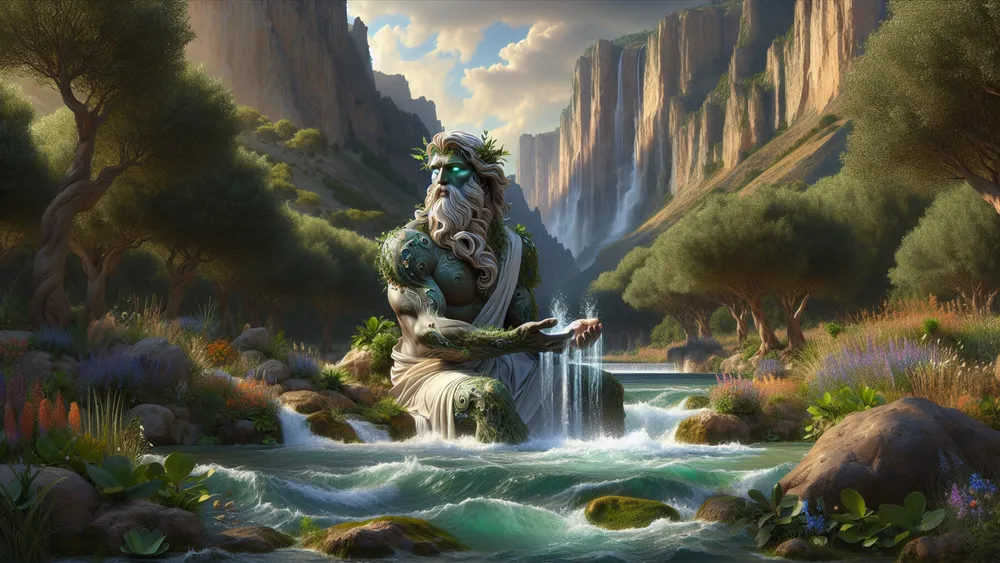
| Aspect | As a God | As a River |
|---|---|---|
| Role | A river god who supports life and brings change | A real river in Thessaly that waters farmlands and shapes the region. |
| Mythology | Father of Daphne and Hypseus, and known for helping people in myths | Takes part in stories about gods and transformation, like Daphne’s myth. |
| Imagery | Seen as a man with a beard lying near water | Flows through the Vale of Tempe, a place admired for its beauty. |
| Geology | Stands for water as something that can create and divide | Created by tectonic activity, important for farming and trade in ancient Thessaly. |
| Cultural Role | Respected in myth as a god tied to fate | A water source critical for the lives of the people who lived near it. |
Myths Associated with Peneus
Peneus has a role in both nature and mythology. He helps form the natural world, affecting landscapes and rivers, while also taking part in stories from Greek myths. These myths include some of the most famous ones about gods and mortals. His involvement in these well-known stories means that mythology and nature are connected in a unique way.
We can now look at how he is part of these myths and what they mean in Greek history and culture.
The Story of Apollo and Daphne
The story of Apollo and Daphne is one of the most well-known tales about love that is not returned in ancient mythology. It was written by the Roman poet Ovid in his book, Metamorphoses. The story starts with Apollo, who is the god of the sun, music, and poetry. He makes fun of the power of Eros, who is the god of love.
To get back at him, Eros sends out two arrows: one sharp and golden, which makes Apollo fall deeply in love, and one heavy and dull, which causes Daphne, a beautiful nymph and the daughter of Peneus, to reject every kind of love. Apollo cannot hold back his feelings for Daphne. He desires her completely and chases after her no matter what.
But Daphne, who is scared and wants to stay free, begs her father, Peneus, to help her. Peneus does not wait long. To protect her, he uses his divine power to change his daughter into a laurel tree. Her body turns into wood; her arms become branches, and her hair turns to leaves.
Though she is no longer in her human form, she is now safe. Nobody, not even Apollo, can have her. Apollo, brokenhearted, cannot undo what happened. He decides that the laurel tree will always be special to him. He promises that it will forever be a symbol of greatness. Its leaves will be used to crown victors and poets, celebrating their achievements and making them unforgettable.
This is why the laurel tree became so important in Greek and Roman traditions. Athletes and warriors came to see it as a prize for winning, and artists and writers thought of it as a sign of creativity and skill. Pictures of Apollo often appear with him wearing a crown of laurel leaves, showing how linked he is to the tree.
Even today, the laurel tree’s story is remembered far beyond its earliest telling. The idea of recognizing hard work and success with a plant shows up in modern traditions too. For example, the phrase “resting on one’s laurels” comes from this story. Through this myth, Peneus did more than just save his daughter.
He helped create an idea that has lasted for thousands of years, ensuring that the laurel tree continues to remind people of the story of Daphne and Apollo.
The Lapiths, Centaurs, and Peneus’ Part in Their Legends
In Greek mythology, Peneus’ influence continues through his son Hypseus, who ruled as king of the Lapiths, an important tribe from Thessaly. Hypseus, as the son of a river god, had both a divine origin and a connection to the natural world. This connection helped confirm his leadership over the Lapiths, a group that played a central role in many famous Greek stories.
It also helped explain the strength and power of the Lapiths, showing why they were seen as courageous and culturally important. The Greeks often used gods in human family trees like this to explain why certain leaders succeeded. The Lapiths are most famously connected to the Centauromachy, which was a large fight between the Lapiths and the Centaurs.
This fight happened during the wedding of another Lapith leader, Pirithous. At the wedding, the Centaurs, creatures that were part human and part horse, disrupted the event. They tried to steal the bride, Hippodamia, and other women from the Lapiths. Chaos broke out. The Lapiths fought back, resulting in a violent and important battle.
Many Greeks saw this fight as a symbol of two sides: the Lapiths stood for order and civilization, while the Centaurs represented wild, uncontrolled behavior. The fight between the Lapiths and Centaurs was repeated in many Greek stories and artworks. It stood for the ongoing tension between culture and chaos, a theme the Greeks explored often.
Peneus, though only indirectly involved, influenced these myths through his son, Hypseus, who came from his divine lineage. This strengthened the Lapiths’ claim to rule Thessaly, a region shaped by Peneus’ river. For the Greeks, divine ancestry gave mortal leaders their power, and here, Hypseus’ connection to Peneus provided that legitimacy.
The Centaurs, often found near rivers and forests, were linked to the wild forces of nature. This made an interesting contrast with Peneus, who symbolized peace and life as a river god. Through his son Hypseus, Peneus’ influence became part of the Lapiths’ many struggles, tying his legacy to these famous battles, where order, leadership, and heroism stood against uncontrolled chaos.
How Peneus Shaped Thessaly’s Landscape
In ancient Greek myths, Peneus was not only a river god but also an important figure in creating the land of Thessaly. He is best known for his connection to the formation of the Vale of Tempe, a narrow gorge located between Mount Olympus and Mount Ossa. The story says that Peneus’ waters moved with great strength through the area, shaping the gorge as they passed through.
People in ancient times thought that gods like Peneus were responsible for making natural features like this. They believed that divine power created spaces in nature that were important or beautiful. The Vale of Tempe was often described in myths as a place of amazing beauty. It was said to be home to nymphs or a path that gods used when they came to earth.
But from a geological point of view, it came from tectonic shifts and the movement of the earth. While this physical explanation exists, the Greeks connected this amazing place to Peneus, giving the land spiritual meaning. They believed that the beauty of nature was tied to the gods who cared for it.
For people at the time, Peneus’ waters were a key part of making Thessaly rich in both natural and cultural value. It wasn’t just the river that mattered. It was how they saw the river’s work as a mix of divine power and natural forces. Through this, Peneus became more than just a god of water.
His flow gave rise not only to the land’s physical beauty but also to the importance of Thessaly’s myths, which connected gods and the physical world in a strong, balanced way.

Peneus, a river god in Greek myths, was believed to have shaped the Vale of Tempe, blending divine power and natural forces to create Thessaly’s land and myths.
Peneus in the Broader Pantheon of Greek Mythology
As a river god, Peneus holds a vital position among the Greek gods. He connects nature, like rivers and valleys, with the world of the divine. This mix of the natural and godly makes his role stand out. We can take a closer look at how Peneus relates to other river gods, as well as how he is shown in ancient art and myths.
His name appears in many famous Greek stories, where gods like him played a part in explaining nature’s beauty and power. Peneus plays this role in a way that links rivers to both ordinary people and the divine.
River Gods in Greek Stories
In Greek myths, river gods, also called Potamói, were connected to specific rivers. Each god represented a river and was considered important. These gods didn’t just control water; people believed they helped plants grow, kept people alive, and marked the edges of land. More than that, they were thought of as powerful beings who could influence crops, set borders, or join in famous stories about gods and heroes.
Achelous was one of these gods. He represented the largest river in Greece, and people saw him as a symbol of growth and change. He even competed with Heracles to marry Deianara by using his ability to turn into different animals, such as a bull and a snake. Scamander, another river god, became part of the Iliad. He brought his river to life and flooded his waters to fight Achilles.
Then there’s Alpheus, who is remembered for falling in love with Arethusa, a nymph. This story tied him to other rivers, even ones in far-off places like Sicily. Lastly, Peneus may not be as involved in action-packed myths, but he is well-known for shaping the Vale of Tempe and for being a father figure in the stories of Daphne and Hypseus.
Here are a few examples of these river gods and their roles:
- Achelous: A god tied to Greece’s largest river, known for fertility and transformation. He fought Heracles for marriage rights.
- Scamander (Xanthus): A Trojan river god who attacked Achilles with his waters during the Iliad.
- Alpheus: A romantic god connected to the nymph Arethusa. His story mixes Greek and Sicilian myths.
- Peneus: Famous for shaping the Vale of Tempe and appearing in stories about his children.
These stories mean that river gods were not just about water. They stood for nature, survival, and even protection. At the same time, they were part of the bigger myths about gods and people.

Peneus in Greek Art and Stories
In ancient Greek art, Peneus often appears as a well-known river god, connected to rivers and flowing water. He is commonly seen in vase art and sculptures. In these works, Peneus is shown as an older man with long hair and a beard. These features help people see his strong tie to nature and rivers.
Symbols like reeds, water urns, and aquatic plants are sometimes added next to him to make sure viewers understand that he is a Potamós or river god. When it comes to literature, Peneus is perhaps most famous for his role in the story of his daughter, Daphne, in Ovid’s Metamorphoses. In the story, Apollo chases Daphne, and she begs her father to help her.
To save her, Peneus changes her into a laurel tree. By doing this, he protected her from Apollo. This transformation became a well-known symbol in Greek and Roman culture. The laurel tree was later connected to victory and poetic success. The scene where Daphne turns into a tree, with Peneus nearby, has been included in Roman art and even art from the Renaissance.
These works helped keep the story alive and gave it a place outside of Greece. They showed how people at the time imagined their gods as deeply connected to natural things around them, like rivers and trees, which were so important to life.

Geographical Features as Gods in Greek Myths
The Greeks often thought of geographical features like rivers, mountains, and valleys as gods or spiritual beings. This was how they connected the natural world to the spiritual one. Rivers like Peneus helped civilizations survive, and mountains such as Mount Olympus were seen as holy places where people believed the gods lived. These ideas were not random.
They reflected how much these natural places meant in everyday life. By thinking of rivers and mountains as gods, the Greeks gave special meanings to the natural world. For example, rivers often stood for life, since they helped crops grow and provided water for people. River gods such as Achelous, Alpheus, and Scamander are examples of this idea.
They were thought of as protectors of the land or even as powerful enough to control nature. Mount Helicon, on the other hand, had a different purpose. People thought of it as the home of the Muses, which meant it was connected to ideas like inspiration and creativity. For anyone who wants to know more about how rivers, mountains, and valleys became part of Greek myths, you can check this Greek Geographical Concepts list.
This list explains how the Greeks made the places they saw around them into spiritual parts of their culture and beliefs.
FAQs
1. What powers does Peneus possess as a river god?
The powers Peneus possesses as a river god include controlling the flow and fertility of the river that bears his name, influencing the natural landscape, and presiding over the life-giving qualities of freshwater.
2. Was Peneus worshipped in ancient Greek religion?
Peneus, as a river god, was not the focus of widespread worship but was venerated locally in Thessaly where his river was seen as vital to the region.
3. What is the most famous myth involving Peneus?
The most famous myth involving Peneus is the tale of his daughter Daphne, who was transformed into a laurel tree to escape Apollo’s pursuit.
4. Who are Peneus’ notable descendants and what role do they play?
Peneus’ notable descendants, such as Daphne and Hypseus, play significant roles in mythological narratives that highlight themes of transformation and heroism, with Daphne becoming the laurel tree and Hypseus serving as a Lapith king.


